Bloomington hosts pet expo show
 On … Continue Reading ››
On … Continue Reading ›› By: Wesley Sewell, Drew Foertsch, Haoran Zhu
BLOOMINGTON, Ind. (April 3, 2025)
Yaoxin Wang remembers the first time she picked up a guitar. She was just a child, drawn to the instrument because of her father. Music was her identity. By middle school, she was performing on stage with the band. In high school, she was accepted into the prestigious Art Department of PLA University, a significant step toward her dream of becoming one of the most famous female guitarists in China.

Then, in a single, unexpected moment, everything changed.
But what was meant to be a reward turned into an unexpected tragedy. A serious motorcycle accident left her middle and ring fingers too weak to hold the strings. The realization hit her hard, “I can’t hold the strings anymore. I can’t go to the university that accepted me,” Wang says. Just like that, her dream was shattered.
When her father recalls the memory, he says, “When she got that acceptance letter, we thought everything was falling into place.” We could not have imagined how swiftly it would all change. She desired that motorcycle so intensely. At the time, all we wanted was to see her happy,” he says in a hushed tone. “Looking back… it’s hard not to ponder.”

Losing her ability to play was not just a setback, it was a devastating blow. Music had been her passion, her plan for the future, and her way of expressing herself. Without it, she felt lost. “Sometimes people have to say goodbye to their dreams,” she reflects. “But there is no correct answer in life, nor is there a universal formula.” The struggle of letting go was real, and the pain was palpable.
Instead of music school, she looked to study law at Indiana University. It was a decision rooted in stability, a practical career path. But no matter how much she studied, something was missing. Law was logical, structured, and rigid. Wang was lacking the creative challenge that she was familiar with.
For Wang, reinvention came in a form no one could have predicted: fashion.
She had always admired fashion but never considered it seriously. It was not until law school that she realized how much she cared about it. Instead of focusing on what she had lost, she started thinking about what she could create. She emphasizes the importance of personal growth, saying, “The harder thing after giving up your dream is whether you have a stronger heart to adjust yourself.”
Although her family did not fully understand her decision, they later expressed their praise: “At first, we didn’t know what to think. Law school made sense. A clothing store? That was unexpected,” he laughs. “But now I see it’s the same creative fire, just expressed differently.”
She began researching the industry, sketching ideas, and learning the business side of fashion. Over time, her new dream became a reality. Now, at 29, Wang is preparing to open her clothing store in Indianapolis.
Opening a store is not the type of performance Wang had thought she would be doing at this point in her life.
Performance is not just about being on stage. It is about dedication, passion, and pushing forward despite unplanned things. Wang may not be playing guitar under the spotlight like she once dreamed of, but she is still performing in a way she never expected. Succeeding where others have failed in her situation is what makes her powerful.
Wang says the most surprising part of starting her store has been the freedom. After years spent studying case law and reading dense legal texts, she now wakes up excited to pick fabrics, arrange displays, and speak with customers. “I finally feel like I’m doing something that reflects who I am,” she says. The store isn’t just a business, it’s a space where she can rebuild confidence and connection. Each outfit she curates is like a message: a way to communicate identity, much like she once did through music.
Wang’s story is a testament to the adaptability of dreams. Life is full of adversity, sometimes we’re forced to take a different path or change our dreams altogether. But as Wang has shown, a new dream can be just as promising as the one left behind. Wang’s story demonstrates that no matter what life throws at her, she will conquer it. This is a powerful reminder that you can rise above any challenge, no matter how daunting it may seem.
Short Interview:
Full Content:
###
By Izzy Hamilton, Cayman Werner and Brayden Kenworthy
BLOOMINGTON, Ind (Apr. 3, 2025)
Powerful and resonant tones soared through the air as Daniel plucked the tough strings of the cello. Deep and soulful melodies transport the audience into a warm and peaceful place, allowing the music to create a deep sense of satisfaction.
The Jacobs School of Music at IU is a highly competitive musical program that only accepts 25% of applicants annually. The hours of dedication to practice and juggling school work can be demanding for students at Jacobs. Daniel Gruber, a current sophomore at Jacobs with a cello performance major, has been interested in music since a young age. Growing up, his mom played violin professionally, which allowed him to grow a deep-rooted appreciation and love for the musical arts.
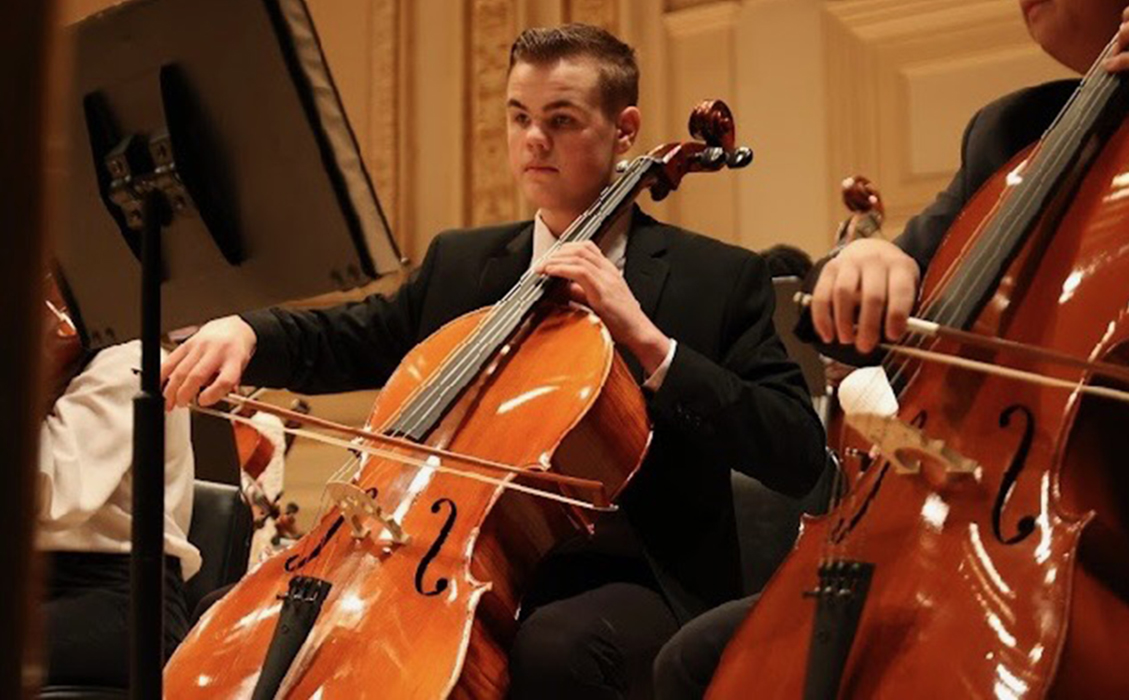
“One day, I was like Mom, what is that? And she said, ‘It’s the cello,’” said Gruber. From then on, he was hooked and said that even when the cello was too big for him to play, he still wanted to hold it and begin learning as soon as possible.
In addition to being exposed to music so early in life, Gruber often got the opportunity to attend professional orchestra concerts. He mentioned how in high school, he remembers “just sitting there and enjoying the sound.” He even compared it to a “mini vacation.” Gruber discussed how his goal is to provide that experience for other people, which is what initially made him want to pursue music full-time.
Gruber was introduced to Jacobs by attending a pre-college program, and while there, a professor suggested that he attend the school. Gruber mentioned that the first semester of college went pretty smoothly, but his schedule quickly amped up as he was juggling a number of difficult classes, joined a quartet, and was feeling a lot of pressure from his professors.
“It’s definitely difficult, and definitely a lot of work, but always rewarding,” said Gruber.
When asked how much time he devotes to the cello a week, he said, “A week?! Can I just give you a day, and you can go from there?” He then walked us through a typical day in his life, where he stated he has classes in the morning, rehearsals in the afternoon, and then practices on his own in the evening. He concluded that he most likely spends around six to eight hours a day dedicated to playing the cello.
A vital part of Gruber’s life is his faith. Growing up, he was always a part of the youth group at church, served on a worship team, as well as served on the adult and youth music teams. He got involved with the Christian Student Fellowship through his friend Abby, who did her undergrad at IU. When she heard that he was coming here, she reached out to him and suggested he join the CSF community. He mentioned that IU can be very dark and lonesome at times, so at the end of the day, it’s nice to be able to come home and have faith-based conversations with genuine friends that are going to influence him positively.

In Gruber’s words, “CSF is a house where around 50-60 residents live and a place where you have the opportunity to live in a Christ-centered community that provides fellowship, services such as small groups and encounter on Thursdays, and a very intentional community.”
Balance as a college student can be extremely difficult, even without the extra challenges of being a competitive music major. When Gruber was asked about how he is able to balance all of the most important aspects of his life, he said, “I try to keep school at school.”
It is important to Gruber that when he comes back to CSF at the end of the day, he can dedicate his time to community and fellowship. In addition, he makes sure to attend the worship services on Thursdays as well as church on Sundays.
Gruber talked about how when the cello is time-consuming, he tries to keep the mindset that “it is [his] worship.” He likes to view the cello as a way that he is working for the Lord instead of his professor. He mentions that this can be extremely difficult at times, but he tries to stick to it.
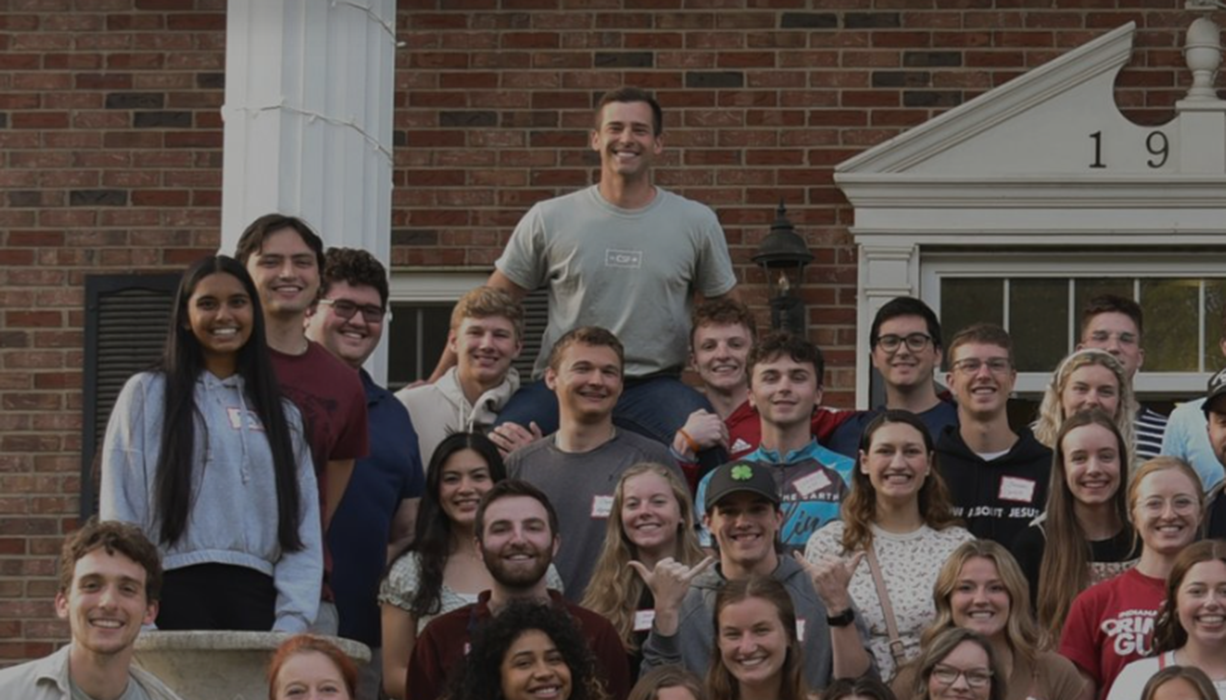
Ben Geiger, CSF’s lead campus minister, said that Gruber is very active, cares about the CSF community, and is friends with pretty much everyone in the house. “He’s very involved in small groups, as well as very passionate about helping serve on campus, as well as at the CSF house,” said Geiger.
He then told a story about a time when Gruber and a group of his friends asked if a special exception could be made within the CSF house so that more people could live there. “Legally, we can room up to four people a room, but typically the only leases we offer are for two to three people to a room,” said Geiger. This situation is an example of how Gruber puts others before himself and makes faith the center of his life. “It just shows a little bit of his heart,” said Geiger.
Daniel displays grit and determination to balance a rigorous school schedule, intense cello expectations, as well as social and faithful fulfillment. By keeping faith the center of his life and dedicating his time to what matters most, he is able to maneuver his laboring college life with a smile each day.
https://www.youtube.com/watch?v=z8Jo4orhUd4
Daniel Gruber, a cello performance major in the Jacobs School of Music, balances his life of music and faith through excelling in academics and the Christian Student Fellowship at IU. He finds fulfillment in both worlds, despite their differences.
By: Anna Bryson, Olivia Glasgow, Ella Chastain
Bloomington, Ind. (April 3, 2025)
The gym at Bedford North Lawrence High School hums with the familiar squeak of sneakers on polished wood and the thud of basketballs bouncing on the court. But recently, something else has been stirring among the players, a quiet movement that began with one athlete and spread throughout the team like wildfire.
Jacob Ritter, a senior basketball player, stands at the heart of it. He leads his teammates in prayer before every game. Once just a personal ritual shared with his best friend and teammate Colton Taylor, the prayer circle has grown to include the entire team, an unplanned but powerful evolution that Ritter never expected.
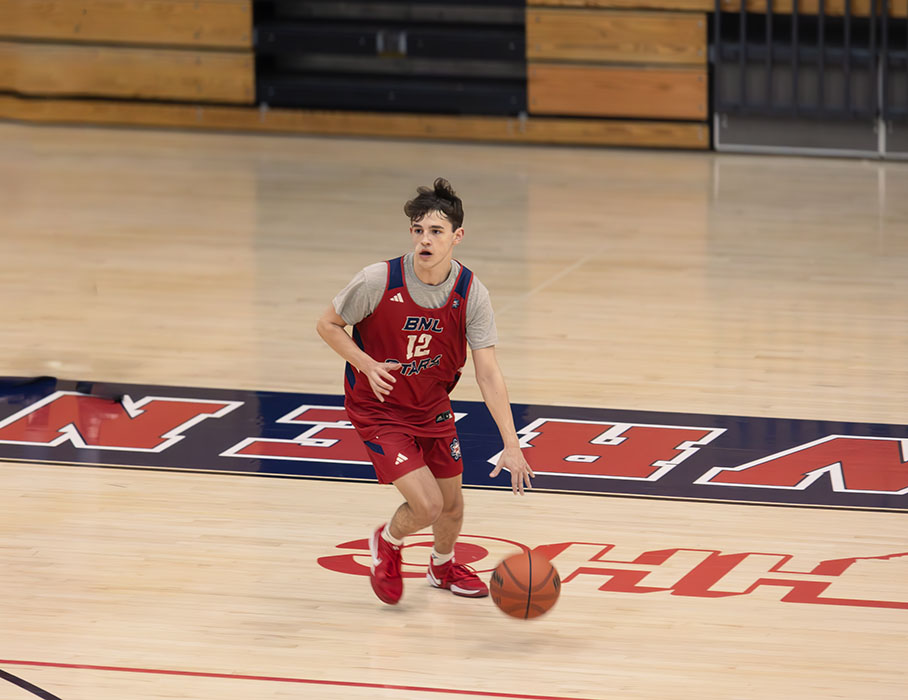
For Ritter, the story goes much deeper than basketball. Just a year ago, he was in a dark place, distanced from his faith and living a life he now describes as filled with mistakes and regret. “I was doing things I shouldn’t have been doing and getting far away from God,” Ritter admits, reflecting on a time when he felt lost and disconnected. But one night, while playing video games at home, everything changed.
Jacob’s mother, Summer Ritter, approached him unexpectedly and began talking about Christianity. Initially, he was angry, brushing her off as he had done before. But something was different this time. As his mother continued to speak, Ritter felt his muscles relax and an overwhelming sense of peace wash over him. Then, as Summer prayed and began speaking in tongues, Ritter felt something break inside of him.
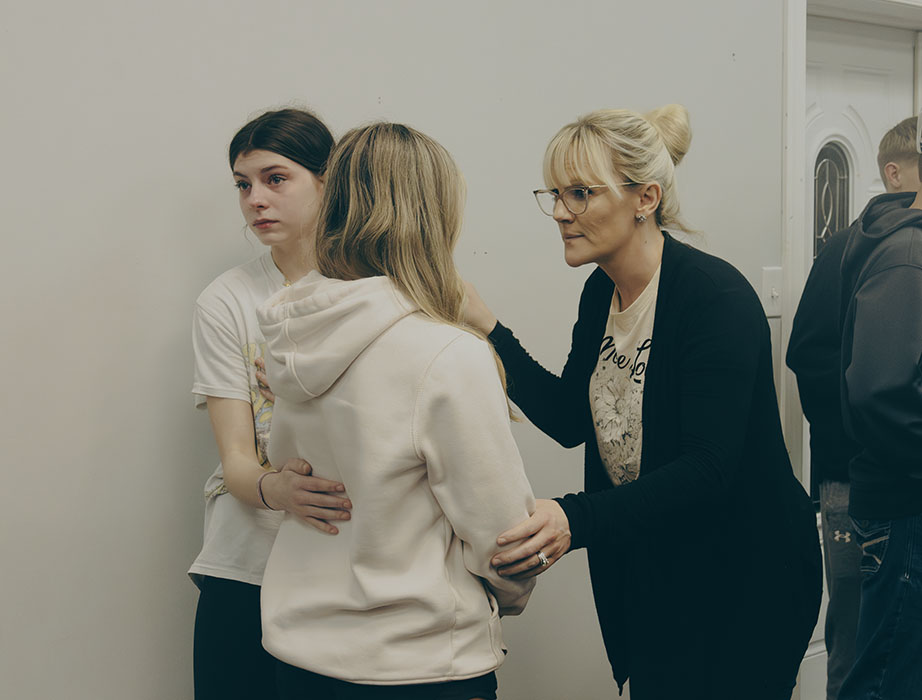
It was a turning point that Ritter could not ignore. The next day, his friend Colton asked if he could take him to church. Ritter shared his encounter with his closest friends, and that Wednesday night, they all went together, not for God, but to support their coach, Brayden Tidd, who was preaching. To everyone’s surprise, by the end of the night, Ritter’s friends had also dedicated their lives to Christ.
From that moment, everything changed. Not only did Ritter renew his faith, but he also found himself guiding his friends on their own spiritual journeys. What started as a private transformation soon became a community of belief and support, bound by their love for basketball and God. “God moved through me first to reach them,” Ritter says, still humbled by the impact of his journey.
Summer, who has been a youth leader at their church for several years, saw the difference in her son immediately. Once angry and distant, Ritter had become joyful, open, and compassionate again. “When he walks into a room, he brings God with him,” Summer says proudly. “There are no words to watch your son minister to other people and save their lives.”
As Ritter’s faith grew stronger, his influence stretched beyond his inner circle. Teammates who had once watched from a distance began joining the prayer circle. Ritter found himself leading his team, sharing faith and purpose. The circle expanded game by game until, at their final game, every player joined hands in prayer, a moment that brought Ritter’s journey full circle.
Ritter acknowledges that giving up old habits and friends was one of the most challenging aspects of his transformation. He knew that rededicating his life to Christ would mean leaving behind things he once clung to. “It was the best decision of my life,” he says. “But it wasn’t easy.”
Now, Ritter’s passion for faith and basketball are intertwined. His performance on the court has improved since his rededication, and injuries seem less frequent. “I used to pray before games like it was nothing,” he recalls, admitting that his heart wasn’t in it. But now, every prayer carries weight and purpose, reminding him that God’s light is meant to shine through his actions.
Off the court, Ritter hosts Bible studies at his family’s home, an idea he proposed to his parents, Summer and Jeff Ritter. What began as a small gathering has since grown, with friends inviting more people and church leaders joining to guide the discussions. Ritter knows that a church is more than a building, it’s the people who make up the community.
As the team prepares for sectionals, where they’ll face the number six team in the state, Ritter’s perspective remains clear. It’s not just about winning games but about fulfilling his purpose. “God put us on this earth for a reason,” he says. “We just have to dig deep and follow our paths.”
Looking back, Ritter sees his journey as one not only of personal redemption but as a source of hope for others. His story is a testament to how faith can redefine a life, and how one young man’s decision to let God lead has transformed a team, a community, and himself.
On and off the court, Ritter leads with himself a growing purpose. His passion for faith has drawn teammates and friends into a growing movement.
By Luke Voss, Lexi Bunting, Whitney Stephen
BLOOMINGTON Ind. (April 3, 2025) — At Indiana University, Jada Tamia Parks has built something special from the ground up. As the founder and creator of M3 Productions, a production house that focuses on movies, music, and media, she’s brought together a group of like-minded students who share her passion for the film industry. For Parks and her team, M3 isn’t just about creating—it’s about learning, growing, and gaining real-world experience together, all while still in college. “The goal is really for all of our members to get really immersed in the film industry as much as we can at this age,” said Parks. 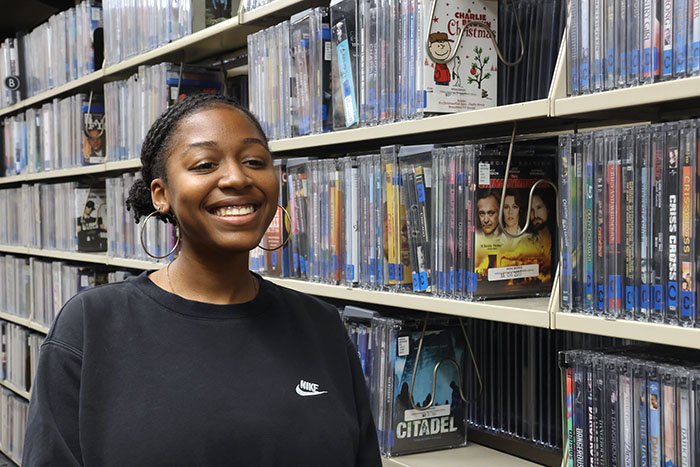
Jada Tamia Parks finds creative sparks in the depths of the Well B. Library film collection. She is one of the founders and creators of M3 Productions and she is always looking for an idea to stick. Photo L. Bunting
Made up of a group of freshmen at Indiana University, M3 Productions is taking their passion for film to new heights, with plans to turn their shared vision into a recognized presence on campus. The group, composed of talented students eager to make their mark in the film industry, is still in the early stages of their journey—but their ambition is already clear, to build a diverse catalog of films on their YouTube channel and establish themselves as a serious force in amateur production.
Through collaboration and dedication, they aim to demonstrate their skills and creativity, earning credibility within both the student body and the larger film community. With hopes of becoming an official student club by next year, M3 Productions seeks to create a space where aspiring filmmakers can come together, learn, and grow through hands-on experience. The group’s efforts reflect not only their individual passions but also their commitment to building a lasting impact on IU’s creative landscape.
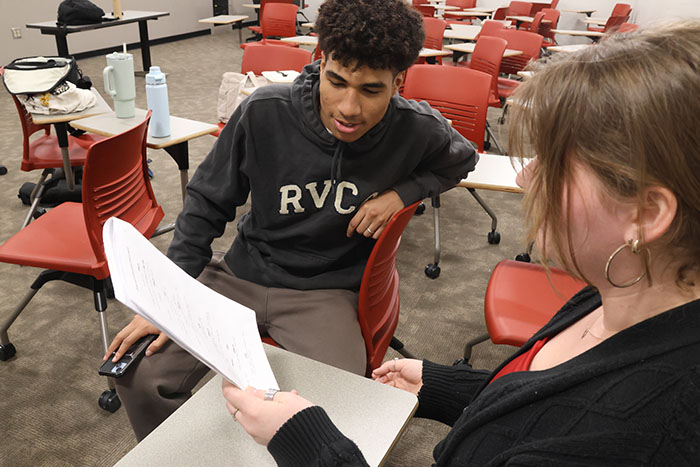
Reading over script after script Isaiah Hamilton practices lines with co-actor Elizabeth Hauser. Hamilton is often know for going off script and improving but will look over the script before takes. Photo L. Bunting
The statement we want to put out there is that you’re never too young to start,” said Jada Tamia Parks, founder of M3 Productions. “Though we’re all young, we don’t feel the need to wait for opportunities to come to us or for things to be handed to us. We’re taking initiative and starting now,” she added, emphasizing the group’s drive to create and take control of their future in the film industry.
Currently, M3 Productions is focused on Wavelength, their latest project, which delves into the experiences of students entering college for the first time. This project aims to capture the unique and relatable stories of new students navigating the challenges of higher education. In addition to Wavelength, the group has recently completed several short films, showcasing their growing range and talent. Many members of the team take on multiple roles, working behind the scenes in production as well as stepping in front of the camera as actors. Despite the demanding workload, every member remains passionate and enthusiastic, eager to contribute to the group’s vision. Their dedication to the work is a testament to their commitment to storytelling and their drive to connect with an audience that can relate to their work.
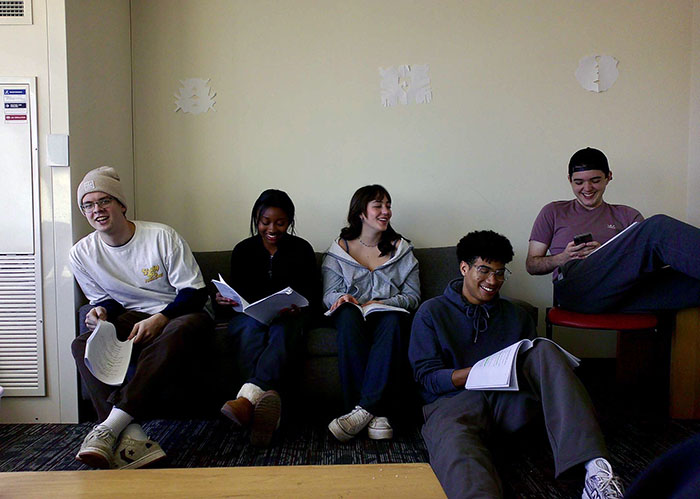
Group of actors and actresses of M3 Production sit and wait in between filming shots. Due to the amount of time member of M3 Productions spend together many great bonds have been established. Photo E. Hauser.
As a group, M3 Productions is always on the lookout for new projects to take on. Every biweekly, they hold pitch meetings to discuss the scheduling, details, and progress of current projects, as well as brainstorm ideas for new projects. One of the group members, Max Brinkmeyer, is currently working on a script that tackles the powerful theme of overcoming addiction. “I think portraying tough subjects within young adult media is important. We want these scenes to speak to people,” said Brinkmeyer, emphasizing the group’s desire to create work that resonates with a wide audience. These pitch meetings can become chaotic at times, as multiple voices compete to share ideas and get their thoughts heard. Despite the lively discussions, the group thrives on collaboration and creativity, using each meeting as an opportunity to refine their vision and take their projects to the next level.
One of the biggest struggles M3 Productions faces is working with limited resources as college-aged filmmakers. Being young artists comes with its own set of challenges, and the group is no stranger to the reality of tight budgets. ‘We are all just broke college kids trying to get something out there, we want to put time and effort into it,’ said Isaiah Hamilton, the creator of M3 Productions. Despite the financial obstacles, the group remains dedicated to their craft, finding creative solutions to bring their projects to life and push forward with their passion for filmmaking.
By Danny Durkin, Naomi Maurer and Ursula Stickelmaier
The stage is dark as people file into room 015 in the Fine Arts Building. Music blasts from the speakers above. And, as the audience finds their seats, members of IUs sketch comedy group Boy in the Bubble wait backstage for the show to begin. Performing comedy can be intimidating for anyone, but joining an established group like Boy in the Bubble comes with both rewards and challenges.
The group’s newest performers, junior Claudia Logan, sophomore Grace Parton and freshman Jesse Kunst, joined the group in January this year. Shortly after officially joining Boy in the Bubble, the group held their first show of the semester, or their “New Kids” show, on Feb. 1 in the Fine Arts Building.

Despite their prior individual performing experience, this was the first time that the three new members performed sketch comedy in front of an audience. But being comfortable on stage is also something that these performers must be good with. For a new performer, like Logan or Parton, the thought of trying to be funny in front of a crowd of strangers may seem nerve wracking at first.
“It was intimidating,” Parton said. “I’d seen them all perform before, and they’re all very naturally funny. And you’re just intimidated going in. Like, I have a lot of imposter syndrome, thinking I’m not funny, or I can’t write, or anything like that. But the more you’re around people like that, I feel like, the more you’re like, oh, that’s silly. These are just fun people to be around. There’s nothing to be worried about.”
Though all the new members of Boy in the Bubble have had some sort of stage experience – Parton, whose current major is costume design and who acted in high school, has been around the stage more than most. Despite currently working in shows with the University Players, some free time in her schedule allowed Parton to audition for the group.
“This semester, I didn’t have much going on, so I kind of wanted to take the opportunity,” Parton said. “And I’d been to a few shows before, and Bubble was always my favorite, so I wanted to try it out.”

With her obligations to school, the University Players shows and her own social life, the addition of Boy in the Bubble rehearsals and shows to her schedule can become a challenge. But to Parton’s surprise, the sketch comedy group is very accommodating of its members’ schedules.
“Bubble makes it easier, because we meet every other week, so I can kind of focus on my other obligations in the weeks in between,” Parton said. “Three of our members were just in Too Much Light Makes The Baby Go Blind, which is the main stage play this semester, and they just took a few weeks off. So, like, a few weeks is only three shows, and they’re going to be back with us the rest of the semester. So it’s not too bad.”
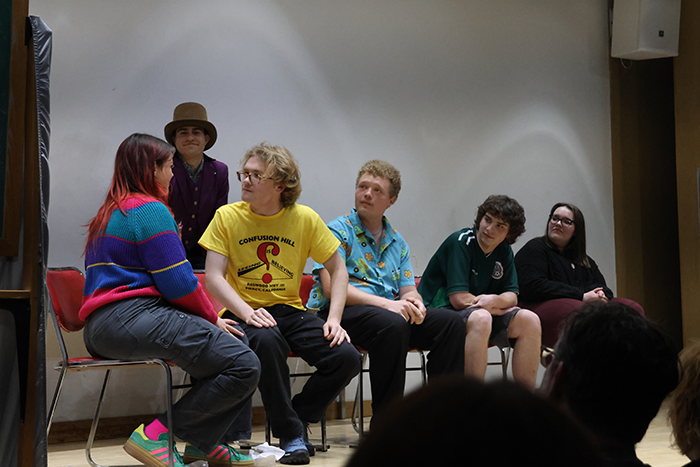
Writing sketches can also be something that challenges new members during their first tries. Logan, who wrote scripts when she was younger for the global organization Destination Imagination which she participated in, has pitched multiple sketches to Boy in the Bubble and has even had some make it into the shows. As her time in the group has progressed so has her process for writing scripts. Currently this means pulling from things she experiences or hears in her own life to create something funny.
“I find one thing that I’m like, ‘Okay, this would be funny. How do I build up to that?’” Logan said. “Like this skit that got in the show, I got from talking to my neighbor. He was making a pie and said something like, ‘My God, my butter is gonna be melted and not just softened.’ And I thought that was so funny. Then in one of my classes, my professor mentioned, like the redwood forest. And I was like, ‘Redwood forest and butter. How can I add that?’ And then I just kind of word vomited.”
For Logan, inspiration can come from anywhere. Whether it is a random conversation with a friend, a silly remark she overhears or even a professor’s lecture. The beginning of her writing process is less about crafting a structured narrative and more about chasing what makes her laugh, no matter how absurd the connections might seem.
Now this process may seem chaotic to some, but Logan thinks it’s important to recognize that not every sketch has to make sense. Sometimes the funniest sketches aren’t the ones that have a logical beginning, middle and end but the ones that include a little chaos.
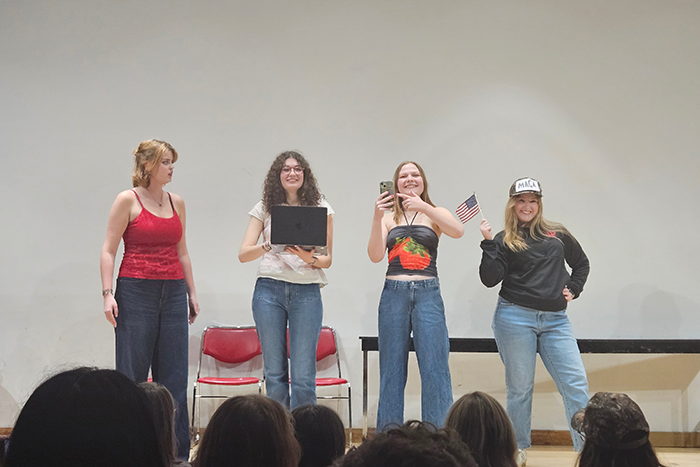
“Sometimes we’ll read sketches, and they don’t make any sense at all,” Logan said. “And it’s okay, it’s just supposed to be funny. So I think, like taking that mindset, it really helps me write too.”
For new members, Boy in the Bubble isn’t just about the challenges it brings. It’s about finding a community where they can grow as comedians. And from writing sketches to performing on stage, Logan says they’ve found encouragement every step of the way.
“Everyone in the group is just so nice,” Logan said. “They all welcomed me in like I was already their friend, so that was pretty comforting.”
Claudia Logan and Grace Parton discuss what its like to be new members of a popular comedy group on campus. Logan and Parton both joined IUs sketch comedy group, Boy in the Bubble, in Jan. 2025 and have participated in all the shows of the spring semester through sketch writing and performance.
By Brady Owen, Phoebe Hyun, and Edward Lewis
BLOOMINGTON, Ind. (Apr. 3, 2025)
As the lights in the theater slowly started to dim, so did the voices in the audience. All Angelo Pizzo could do was take deep breaths in order not to let his worries take over. The air in the theater was thick with anticipation. This was the moment he fought for, a test screening for the film he had poured his soul into. If the audience didn’t like it, well, that was it; it was over. His heart pounded, each beat louder than the last as he watched his film unfold on screen. His mind was restless as he thought about all the challenges he had faced up until this moment. As the end credits rolled and the lights slowly turned on, the entire theater erupted. For a full five minutes, all you could hear were cheers and claps, he had done it. The fight had been worth it. His dream had come true.

It’s the kind of story you’d see in a classic movie: a small-town dreamer with big dreams fighting against all odds to make it in the industry. But for Angelo Pizzo, it wasn’t a movie, it was his life. From his small-town childhood to becoming the creator of arguably the most iconic sports films, Hoosiers and Rudy, Angelo’s journey is one of a dreamer who faced all his challenges head-on. His story is more than just about making movies – it’s about dealing with setback after setback and proving dreams are achieved through persistence, passion, and lessons learned from failure.
Growing up in a small town, Angelo Pizzo never dared to dream of a career that was not “traditional.” It wasn’t until later in life that he found his true calling and was willing to jump into a world of unknowns. Angelo said, “I’ve always loved film, but I’ve never thought of making a living doing it.” He explained how for a good portion of his life, his plan was to work in politics. However, that plan took an unexpected turn after his involvement in the anti-war movement, which shifted his perspective entirely. Disillusioned with politics, he took a step back from the conventional path and decided to “ski a season in Aspen, surf a season in Hawaii, and live on a commune there.”
It was during this time of exploration and self-discovery that Angelo began to reconsider his future. After returning home, his father told him that he’d “support him no matter what, but [Angelo] had to pursue something he loved.” This moment of encouragement marked a turning point in Angelo’s life, propelling him toward a career in a field he never imagined — filmmaking.
Early Struggles
Like many success stories, Angelo’s journey was filled with setbacks. For years, he worked with companies like Warner Brothers and 21st Century Fox until he felt ready to go off and create something on his own.
Initially, Angelo’s approach to filmmaking was more academic. After being told by the head of the comparative literature department that he needed a doctorate from one of three specific schools, he was motivated to do just that. After years of working toward that very goal, he ended up scoring an internship that was usually for production students, he soon began questioning his career choices once more.

After being told by one of the people he was fortunate enough to work with that he “doesn’t belong in academics, you’ve got to be in this business”, he was able to start gaining work experience in development, which led him to become vice president of production.
During the early years in his career, Angelo faced many challenges, rejection and uncertainty being two of them. Yet, he didn’t let anything deter him. Instead, he used it as fuel to push himself forward.
The Importance of Persistence and Passion
For Angelo, the most important lesson in his career was learning to keep going, no matter the odds. He stressed how important determination is for anyone looking to make it in a competitive industry like filmmaking.
Angelo said, “The one thing I was told really early on was you’re going to face a lot of rejection. You’re going to get a series of nos and people discouraging you that you’re not going to make it. And if you allow other people to define what you’re capable of…then you’re finished”.
Despite the setbacks, he refused to let others define his potential became the foundation for his success. By embracing his failures and pushing forward, Angelo ultimately found his place in the industry, creating some of the most beloved and iconic films in sports history. His journey reminds us all that success isn’t about avoiding failure, but about having the grit to rise again and again, no matter how many times you’re knocked down.

Behind the Scenes: Quinley’s Perspective
To truly understand what it’s like to work with Angelo, we spoke to Quinley Bowden, his stepdaughter, who had the chance to work with Angelo on his most recent project. Quinley, who has witnessed Angelo’s journey up close, shared her perspective on what it’s like to see him both at home and on set. “Well, I think that both on and off set he’s a different person… in real life he’s kind of nonchalant… he’s just a guy. But on set, he’s very locked in”.
When asked what Angelo’s previous work means to her, Quinley said, “…these are really inspirational movies. I always feel really good after watching an Angelo Pizzo movie”. We also asked Quinley how working with Angelo on set had impacted her understanding of filmmaking and storytelling. She reflected thoughtfully, “I was involved… for a long time. I read the script months beforehand, seeing the way the movie morphed and changed throughout the whole process was really cool”.

A Legacy of Hope
Today, Angelo Pizzo’s name is synonymous with inspiring stories of hope and perseverance. His films continue to resonate with audiences around the world, showing that the greatest victories often emerge from the greatest struggles. His journey serves as a powerful reminder to anyone chasing a dream — whether in film or any other field — that success doesn’t happen overnight. It’s the result of hard work, passion, and never giving up.
As Angelo reflects on his career, he connects the story of Rudy to the challenges many people face in their own lives. “Rudy seems to inspire people to do a couple of things,” he explains. “To go after their dream no matter how impossible it seems, and no matter how little support you have from your friends and family.” He adds, “Rudy never gave away the power to let others define not only who he was, but what he was capable of. And I think a lot of people are looking for that in their own lives.”
For those just starting out, Angelo Pizzo’s story proves that success in Hollywood—or in any field—isn’t reserved for the fortunate few. It’s for those who dare to dream and have the persistence to make those dreams a reality.

Pizzo highlights important pieces of his film career and how he has reached the tip of the mountain from his humble beginnings
By Raeghan Miller, Jenna Nolot, and Hayden Pope
BLOOMINGTON, IN. (April 3, 2025)
For most athletes, a college career ends with the final whistle of a season-ending game. For Indiana University basketball player Jackson Creel, however, that ending came earlier than expected. A tough injury forced him to step away from the game, which not only altered his season, but also his perspective on basketball and life.
Jackson suffered a foot injury while returning from Christmas break. Initially, the setback had a negative impact on the rest of his season. He was faced with a tough reality that he didn’t expect. He underwent surgery about a week and a half later, holding onto hopes that the healing process would speed up in time for him to return to the court. However, as time passed and the season came to an end, he realized he wasn’t going to get the ending he had imagined.

“It took me a lot of time to readjust,” Jackson said. “It was sad that I had to end my college career without being on the court. The season came to an end, and I still wasn’t able to return. But I’m grateful for the experience.”
When Jackson was first injured, he didn’t think there was much he could do for his team. But over time, his perspective shifted. He realized he could still contribute in meaningful ways without stepping foot onto the court.
“I could bring a lot of energy to practice and drills, be a cheerleader for my teammates, just giving them confidence and enthusiasm,” Jackson said. Even though this didn’t affect his performance, he was able to help his teammates.
This shift in mindset allowed Jackson to be thankful for his season, even though it looked nothing like what he had expected. He appreciated that he had the opportunity to positively impact his team.
Meanwhile, Jordan Rayford, a point guard for Indiana University, was suffering from his own struggles after tearing a ligament in his foot. This injury placed him on the sideline for nine months. During this time, he realized how much he missed playing with his team. He admitted that when you’re healthy, it’s easy to take some moments for granted.
“I became more grateful for things I used to look past, like waking up early for practice,” Jordan said. “It changed how I viewed performance as well. Before I thought about it in terms of how many shots I was making, dunks, and layups. Now, I see it as more than that. It’s how I maintain my health off the court. Getting into the ice tank after practice, working with the trainer, those things became more important to me.
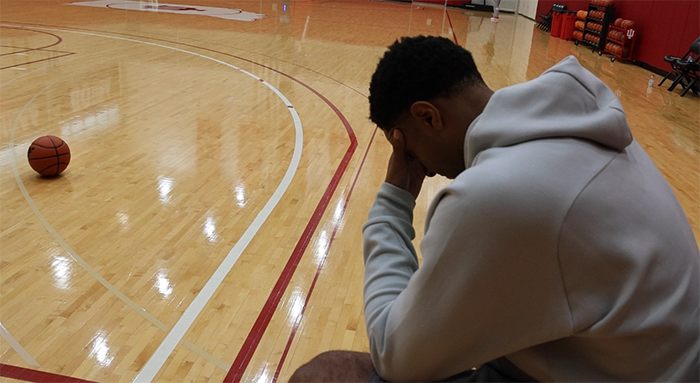
Jordan spent nine months watching his teammates put in the work, giving him a new perspective as a player. Instead of focusing on what he couldn’t do, he used this time to his advantage, watching and improving his skills for his future on the court. “You actually get to watch practice and see where people are making mistakes,” he said. “When you come back, you can fill those voids.”
The shift in mindset helped both players find meaning in their time away from the court. They realized that being a part of the team was an opportunity that shouldn’t be taken for granted, and they needed to appreciate the sport and the brotherhood that came with it.
For other athletes dealing with potentially career-ending injuries, they both offered a piece of advice. Jackson said, “It’s not ideal, but be grateful that you had this opportunity. Bring thankfulness, joy, encouragement, and appreciate that you can impact their performance and help them as much as you can.” Jordan highlighted that his perspective changed after his injury, and it made him the player he is today. He wants others to know that they need to find the positives of being injured.
Though Jackson and Jordan’s college careers went in a direction they never expected, they both have a deeper appreciation for their health, the game, and the impact they can have beyond playing on the court. As Jackson moves on from Indiana University, he takes with him the lessons of gratitude, while Jordan prepares for another shot at the game he loves. Both players have grown through their struggles, proving that resilience, perspective, and gratitude can turn setbacks into opportunities.
https://youtu.be/JS9-2QHR3sE
IU men’s basketball players Jordan Rayford and Jackson Creel open up about their experiences with injury, recovery, and the mental toll of being sidelined. Their stories reveal how performance extends beyond the court and into the personal challenges athletes face off the hardwood.
Bloomington hosts pet expo show
 On … Continue Reading ››
On … Continue Reading ›› By Lauren Wainwright, Chloe LaVelle and Taylor Waterman
BLOOMINGTON, Ind. (April 3, 2025)
Electric energy surged through The Bishop on the night of March 21, 2025. The DIY noise rock band, Mourning Star, took the stage, striking a chord with the audience.
But for the audience, it was more than just a concert.
It was an immersive experience showcasing noise rock’s raw, unfiltered spirit. Founded by Thom Kitchel and Anna Pregger, Mourning Star has become a beacon for those seeking music beyond the polished. They offer a sound that’s as much about connection and inspiration as it is about the music itself. Even being down a drummer for the performance, the members were able to compensate. Nova Hardie moved to the drums while Pregger played bass and sang. Mason Taylor was one of many Bloomington community members at The Bishop that night. “They had a loud encompassing sound that like I just haven’t heard from anywhere else,” Taylor said.

In just one short year, Mourning Star has rapidly grown in prominence. “I don’t know if I would call it a rise to fame. It’s been very fast, but it’s also been very satisfying,” Kitchel said. What began as a small hobby has now become something much bigger. The band has been booking three shows a month and is preparing for out-of-state gigs in the coming months.
While booking shows is critical to their growing success, the true test for any band lies in its dynamic. For Mourning Star, this cohesion is essential. “Our dynamic, I think we work very well. I think that when we perform live, we are really good at it; even if there are little mistakes, we are really good at recovering from those,” Pregger said. Pregger can recall only one instance where the band had to completely reset during a performance—a testament to their strong chemistry and adaptability. But band dynamics don’t happen overnight. “I remember our first ever practice, it was in a garage and we practiced and it was just like ‘oh boy we got a long way to go, ’” Kitchel said.
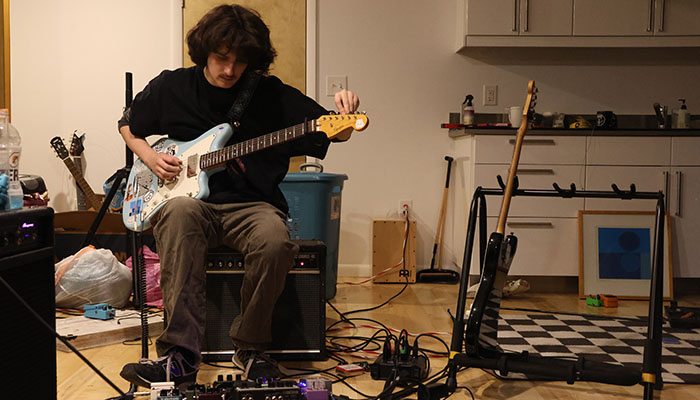
A band has to start from somewhere, it starts with a passion. For Pregger, the dream of forming a band began years earlier, in high school, when she first encountered the DIY music scene. “Hearing that other people could start it with just nothing, just make like garage band music just like in the car, that was very inspirting to me. Throughout high school, I would just make, like, really not good-sounding things, but I would do just sorta the same thing. And I was like, maybe I can actually do this one day,” Pregger said. While she dabbled in music creation throughout high school, it wasn’t until she encountered other college bands and started collaborating with Kitchel that she truly believed it was possible to create something of her own. Kitchel, who moved to IU this year, wanted to create a band that created a sound that was conducive to the sound he was envisioning.
The band goes beyond the music, though, hoping that they can make an impact in the Bloomington scene. Pregger has hope that they have accomplished this goal. “There’s been a couple people that have come up to us after shows who have seen us, and they have been like ‘Wow, you guys make us want to start a band.’ And that’s been sorta crazy to me, and that’s made me want to perform more to inspire people’s goals because like the way that I got inspired was seeing other college students being in bands and being like, oh yeah, I could be able to do that.” Pregger said.

While fame is on the minds of many bands, Pregger has other ideas. “I don’t need to be a big band to be happy. I just want to play with bands that I really like.” Pregger said. The Bloomington scene is shaping up to be a launching pad for the band’s continued success, but the foundation for Mourning Star’s journey lies in their shared passion for creating music that resonates with them. It’s not just about the noise they make on stage, but it’s about the moments of connection that form both within the band and with their growing community of fans.
Mourning Star caught the attention of their audience on March 21, 2025, at The Bishop Bar in Bloomington, Indiana. Beginning in 2024, the noise rock band reflected on their successes and hopes for the future.
By Devon Proscia, Benjamin Cowles and Sam Bowlby
BLOOMINGTON, Ind. (April 3, 2025)
Music had always been part of Claire Carpenter’s life, but it wasn’t until after her accident that she realized just how much it meant to her. A traumatic ATV crash caused severe fractures, nerve damage, and chronic pain, making physical activities difficult. Running, jumping, even standing for extended periods—things she once took for granted—became daily struggles. But rather than let the injury define her, Carpenter turned to something that had always brought her joy—performing.

“I love music, and I love performing,” Carpenter said. “It’s my favorite thing to do. I’m happiest when I’m performing. Singing is a great way to work through my traumas and emotions.”
She wasn’t ready to give up on being on stage, even if it meant adapting. At Indiana University, she connected with guitarist Ahnay Hering through mutual friends who shared their love for music. What started as casual jam sessions quickly evolved into something more. With the addition of a bassist and drummer, OPAL was born. The group found its sound through late-night rehearsals in cramped practice spaces, experimenting with melodies and lyrics that reflected their personal struggles and triumphs. Before long, they were booking gigs at house shows and local venues, earning a loyal following and a reputation for delivering raw, emotionally charged performances.

The band’s music blends indie rock with alt-pop influences, featuring soaring vocals, moody guitar riffs, and deeply personal lyrics. Their songs explore themes of resilience, transformation, and the weight of past experiences, resonating with audiences who see their own struggles reflected in the music. Carpenter’s voice, raw and emotionally charged, serves as the heart of the band, pulling listeners in with every note. Her ability to channel pain into something beautiful has become one of OPAL’s defining characteristics, creating a connection with fans that extends far beyond the stage.
Hering has watched Carpenter’s journey up close. “Seeing her adapt to that and work her way around it or sometimes just fight through it is really inspirational,” said Hering
Despite her love for the stage, performing isn’t easy. Carpenter’s injury means that standing for long periods is grueling, and even short sets require careful planning. She often leans against amplifiers between songs, subtly shifting her weight to relieve pressure. Sometimes, she has to sit for acoustic numbers, a decision that frustrates her but keeps her going. Even walking onto the stage can be an exhausting effort, but the moment the first chords ring out, the discomfort fades into the background.
Carpenter realized that music gave her the same rush as her former passion, cross-country running. The discipline, the adrenaline, and pushing herself beyond her limits—it was all still there. When she steps on stage, the pain fades into the background, and her love for the art takes center stage.
“When I’m performing, I don’t necessarily notice the pain,” said Carpenter.
During OPAL’s performance at The Bluebird, Carpenter knew she was pushing her limits, but stopping wasn’t an option. The music surged around her, and with every lyric, she poured her struggle into the sound, funneling her emotions out toward the crowd. The flashing stage lights, the hum of amplifiers, and the pulse of the bass created an electric atmosphere that made every moment on stage worth it.
The audience moved in sync with the music, drawn in by the band’s infectious energy. Some swayed with closed eyes, letting the lyrics wash over them, while others cheered between songs, hanging onto every word Carpenter sang. Each performance was more than just a set—it was a testament to resilience, to pushing through pain for the love of something greater. Every note was a declaration that she wasn’t backing down, and every song was proof that she could still take up space on stage, on her own terms.
As OPAL’s reputation grows, so do their ambitions. The band has been writing original songs, experimenting with their sound, and dreaming about their next steps. With growing recognition in the local scene, they hope to record their first EP and tour beyond Indiana. For Carpenter, the goal is simple: keep performing, no matter what. There’s always going to be pain, but that doesn’t mean you stop. You just have to learn a new way to move.
Her journey is one of transformation—of redefining what it means to be a performer and a fighter. And as long as there’s a stage, Claire Carpenter will find a way to conquer it.
https://youtu.be/QBbOGN7dZBQ?si=AKipw9nP4eGsE5qn